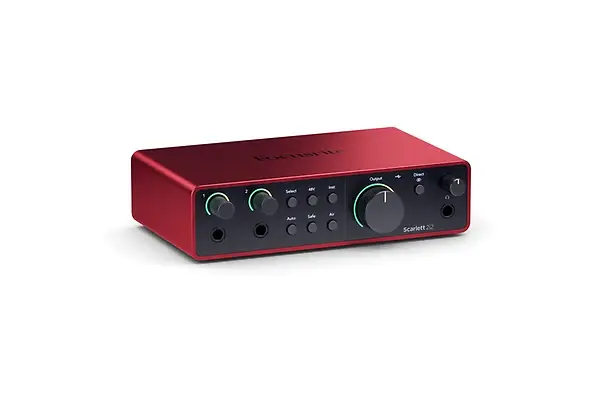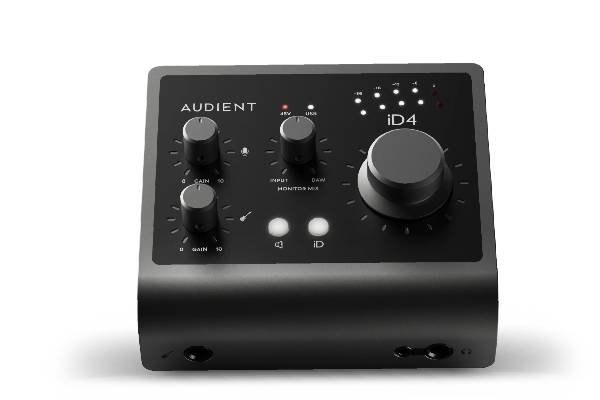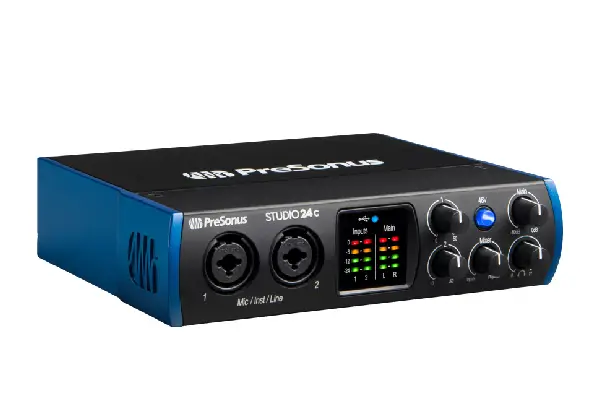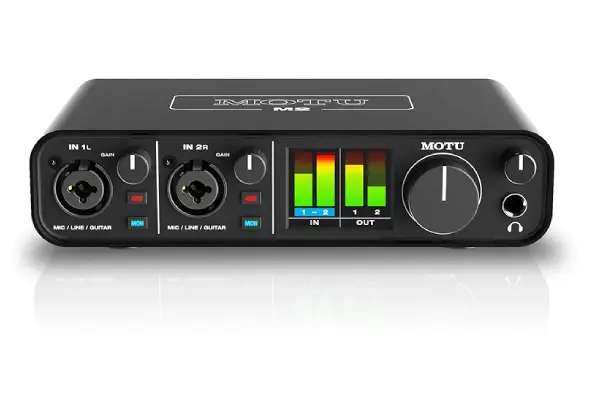Finding the best audio interfaces under $200 has become genuinely exciting over the past few years, as manufacturers continue pushing impressive technology into budget-friendly packages. After spending considerable time with various interfaces in this price range, I’ve noticed how the gap between entry-level and professional gear keeps narrowing—these aren’t just “starter” interfaces anymore, but legitimate tools that working musicians and producers rely on daily.
The reality is that you don’t need to drain your bank account to get clean preamps, low-latency performance, and reliable connectivity. What you do need is knowing which features actually matter for your workflow and which marketing buzzwords you can safely ignore. I’ve tested these interfaces with everything from delicate fingerstyle guitar recordings to aggressive rock vocals, and I’m consistently impressed by what’s possible at this price point.
| Model | Key Strengths | Pros | Cons |
|---|---|---|---|
| Focusrite Scarlett 2i2 (4th Gen) | Cleaner preamps and improved noise floor with classic Air mode in a durable, portable design | • Very clean, quiet preamps• Air mode adds clarity and presence• Stable drivers across DAWs• Strong software bundle (Hitmaker Expansion)• Solid metal construction | • Only two inputs• No MIDI ports• Volume knob feels imprecise• Air mode can be bright on some mics |
| Universal Audio Volt 2 | Budget interface with true vintage coloration via 610-style preamp modeling and built-in 76 compressor | • Vintage mode adds analog warmth• 76 Compressor sounds great on bass/vocals• Excellent build quality• Useful LED metering• High headroom prevents distortion | • Only two inputs• No loopback for streaming• Slightly larger footprint• Vintage mode may be too colored for some |
| Audient iD4 MKII | Premium Class-A console-grade preamps in a compact, portable interface with advanced monitoring features | • Exceptional preamp quality• ScrollControl enhances workflow• Pro monitoring controls (mono, speaker switch)• Excellent JFET instrument input• Very portable | • Only one mic input• No MIDI ports• Mix knob feels less intuitive• Higher cost vs similar 2-input competitors |
| PreSonus Studio 24c | Transparent XMAX preamps + reliable USB-C performance with outstanding Studio One Artist integration | • Clean, transparent XMAX preamps• True USB-C improves stability/latency• Studio One Artist is a full DAW• Extremely stable drivers• Durable metal chassis | • Plain design• Indicators hard to read in bright rooms• Mix knob placement isn’t ideal• No dedicated instrument inputs on front |
| MOTU M2 | Best-in-class conversion and metering at this price; exceptional accuracy for recording and mixing | • ESS Sabre32 converters• Full-color LCD meters• Excellent loopback for streaming• 60dB clean gain for ribbons• Pro monitoring controls (mute, mono) | • Still USB 2.0• Sound may feel “clinical” to some• Smaller software bundle• No MIDI connectivity |
Focusrite Scarlett 2i2 (4th Generation)

The Scarlett 2i2 has been the default recommendation in this category for years, and the fourth generation proves exactly why it maintains that position. After using this interface extensively for both home recording sessions and portable setups, what strikes me most is how Focusrite refined an already solid design without overcomplicating things. The preamps deliver noticeably cleaner gain than the previous generation—I can push them harder on quieter sources like ribbon microphones without that grainy noise floor creeping in around the 50dB mark.
Build quality feels reassuringly solid with its metal chassis, though the volume knob still has that slightly loose feel that some users mention. The direct monitoring control works flawlessly, which matters more than people realize when you’re recording a guitarist who’s sensitive to even tiny amounts of latency. Setup is genuinely plug-and-play on both Mac and Windows, and I appreciate that Focusrite includes their Hitmaker Expansion software bundle—while I don’t use most of it, having Pro Tools Intro and Ableton Live Lite options gives flexibility for producers just starting out.
Pros:
- Exceptional preamp clarity with improved noise performance
- Air mode adds professional character to vocals and acoustic instruments
- Rock-solid driver stability across major DAWs
- Comprehensive software bundle provides real value
- Durable metal construction that survives frequent transport
Cons:
- Only two inputs limits multi-mic setups
- No MIDI connectivity if you’re working with hardware synthesizers
- Volume knob feels slightly imprecise during fine adjustments
- Air mode can be overly bright on some condensers
Universal Audio Volt 2

Universal Audio bringing their heritage into the budget interface market created serious waves, and after extensive testing, I understand the enthusiasm. The Volt 2 delivers something genuinely different in this price range—a preamp circuit that’s actually modeled after UA’s vintage 610 console. I was initially skeptical about whether this would translate into anything meaningful at $199, but tracking electric guitar DIs through the Vintage mode revealed warmth and harmonic saturation that my other budget interfaces simply don’t produce.
The LED metering is more useful than it initially appears, giving you real-time visual feedback that prevents the clipping disasters that plague beginners. Build quality matches what I’d expect from Universal Audio’s reputation—the unit feels substantial, and the controls have precise, professional resistance. One aspect that impressed me during mobile recording sessions was how well the bus-powered mode works; it draws power reliably from my laptop without introducing the ground loop hum that some interfaces suffer from in portable setups.
Pros:
- Vintage mode adds genuine analog warmth to recordings
- Built-in 76 Compressor works beautifully on bass and vocals
- Superior build quality with professional-grade components
- LED metering provides clear visual feedback during tracking
- Excellent headroom prevents preamp distortion on loud sources
Cons:
- Limited to two inputs restricts larger recording scenarios
- No loopback feature for streaming or podcasting applications
- Slightly larger footprint than competitors
- Vintage mode may be too colored for purist recording approaches
Audient iD4 MKII

The Audient iD4 MKII occupies an interesting position in this market—it’s a 1-in/2-out interface that punches way above its weight class sonically. After using it as my portable interface for location recording over several months, I’ve developed genuine appreciation for how Audient prioritized preamp quality over feature bloat. The Class-A microphone preamp design is lifted from their professional consoles, and you can hear the difference immediately when tracking acoustic sources. I recorded an upright bass recently, and the low-end clarity and transient response exceeded what I’ve captured with interfaces costing twice as much.
The monitoring section deserves specific mention because Audient clearly thought about real-world studio use. The speaker switching and mono check buttons are features typically found on far more expensive monitoring controllers, and I use them constantly during mixing sessions. Where the iD4 shows its compromises is the single input—if you regularly need to track stereo sources or multiple microphones simultaneously, you’ll need to look elsewhere. But for solo musicians, podcasters, or producers who primarily work with one source at a time (like exploring different instruments for composition), it’s genuinely hard to beat.
Pros:
- Exceptional preamp quality rivals professional interfaces
- ScrollControl feature dramatically improves mixing workflow
- Professional monitoring controls including speaker switching
- JFET instrument input maintains clarity with hot pickups
- Compact footprint perfect for portable recording setups
Cons:
- Single input severely limits recording flexibility
- No MIDI connectivity for hardware integration
- Monitor mix control could be more intuitive
- Higher price than some dual-input competitors
PreSonus Studio 24c

PreSonus has been refining their Studio series for years, and the 24c represents their most mature budget offering yet. What drew me to this interface initially was the promise of XMAX preamps—PreSonus’s Class-A design that appears in their professional StudioLive consoles. After recording dozens of sessions through it, I can confirm these preamps deliver transparency that serves any genre. I tracked a folk artist’s vocal and acoustic guitar simultaneously, and the preamps captured every nuance without imposing any particular character—exactly what you want when the source material should speak for itself.
The 24c distinguishes itself with legitimate USB-C connectivity that isn’t just for show. The increased bandwidth means lower latency performance, and I’ve noticed more stable operation during demanding sessions with multiple plugin instances. PreSonus includes their Studio One Artist DAW, which honestly might be the best bundled software in this entire category—it’s a full-featured production environment, not a crippled “lite” version. I’ve completed entire projects within Studio One after initially downloading it just to test the workflow integration.
Where this interface really shines is reliability and stability. I’ve had it connected for months at a time, through countless DAW launches and computer sleeps, without a single driver hiccup. That’s not exciting to talk about, but it’s invaluable when you’re trying to capture a creative moment. The front-panel mix control for adjusting input versus DAW playback balance works smoothly, though I wish the indicators were slightly brighter—they’re a bit difficult to read in bright studio lighting. The metal chassis feels durable enough for regular transport, and mine’s survived being tossed in a backpack for mobile sessions without developing any issues.
Pros:
- XMAX preamps deliver transparent, professional sound quality
- USB-C connection provides enhanced stability and lower latency
- Studio One Artist included is a complete production DAW
- Exceptional driver stability across extended use
- Solid construction with reliable hardware controls
Cons:
- Somewhat generic aesthetic lacks distinctive character
- Front-panel indicators difficult to read in bright conditions
- Mix control placement could be more ergonomic
- No dedicated instrument inputs on front panel
MOTU M2

The MOTU M2 entered this market segment and immediately disrupted expectations about what budget interfaces should deliver. After months of using it as my primary home studio interface, I’m convinced it offers the best pure technical performance under $200. The ESS Sabre32 converters aren’t just marketing speak—you can hear the difference in the extended frequency response and low noise floor. I recorded comparison tests using the same microphone and source material across several interfaces in this price range, and the M2 consistently captured more detail in both the high and low extremes.
What makes this interface genuinely special is the metering. MOTU included full-color LCD screens that display real-time level meters for all inputs and outputs with stunning precision. This might seem trivial until you’re tracking a dynamic vocal performance and can actually see exactly how much headroom you’re maintaining. It’s transformed how I approach gain staging, and I’ve noticed fewer clipping disasters since switching to the M2. The loopback functionality works flawlessly for streaming and podcasting applications, which adds significant value if you’re creating content beyond just music production.
The monitoring section is thoughtfully designed with easily accessible controls for speaker/headphone selection and source selection. I appreciate the dedicated mute and mono buttons—small details that reveal MOTU’s professional audio heritage. The preamps deliver clean gain up to 60dB, providing enough boost for even demanding ribbon microphones without introducing noise. Where I’ve found the M2 most valuable is in mixing scenarios; when I’m comparing headphones or making critical listening decisions, the transparent playback chain doesn’t color the sound. The only real limitation is standard USB 2.0 connectivity, though in practical terms, it’s never been a bottleneck during normal recording sessions.
Pros:
- ESS Sabre32 converters deliver exceptional sonic accuracy
- Full-color LCD metering provides precise visual feedback
- Loopback feature perfect for streaming and podcasting
- Clean preamps with 60dB gain handles demanding microphones
- Professional monitoring controls in compact package
Cons:
- No USB-C connection feels slightly dated
- Slightly clinical sound may lack character for some users
- Limited bundled software compared to competitors
- No MIDI connectivity for hardware integration
Choosing the Right Interface for Your Needs
Selecting among these interfaces depends entirely on your specific workflow and priorities. If you’re primarily recording vocals and want that professional sound character, the Universal Audio Volt 2 delivers coloration and compression that genuinely enhances performances during tracking. For producers who need absolute transparency and professional metering, the MOTU M2 provides technical performance that competes with significantly more expensive options.
The Focusrite Scarlett 2i2 remains the safe choice for good reason—it balances sound quality, reliability, and bundled software in a package that serves beginners and experienced producers equally well. I’ve recommended it to countless musicians starting their recording journey, and I’ve never heard complaints about it limiting their creativity. The Audient iD4 MKII makes sense for mobile recording scenarios or producers who value exceptional preamp quality over multiple inputs.
PreSonus Studio 24c offers perhaps the best complete package when you factor in Studio One Artist—you’re essentially getting a professional DAW with a solid interface, which represents tremendous value for someone building their first studio. The reality is that any of these interfaces will serve you well for years; the key is matching features to your actual recording scenarios rather than getting distracted by specifications you’ll never use.
One aspect worth considering across all these options is how they’ll integrate with your existing gear and workflow. If you’re regularly working with samples and beats you’ve discovered through platforms like various songs categories, you’ll want an interface with reliable low-latency monitoring. For musicians recording live instruments, preamp quality and headroom matter more than feature count. The best interface under $200 is ultimately the one that disappears from your creative process—reliable, transparent, and effortless enough that you’re thinking about music rather than troubleshooting technical issues.
Understanding Key Specifications
When evaluating audio interfaces, certain specifications deserve more attention than others based on real-world impact. Sample rate and bit depth numbers get thrown around constantly, but honestly, 24-bit/48kHz recording is more than sufficient for professional results. I’ve released commercial work recorded at these settings, and the limiting factor is always microphone placement and performance quality rather than converter resolution.
Preamp gain range matters more than most beginners realize. If you’re planning to use dynamic microphones or ribbons, you need at least 60dB of clean gain to bring those quiet sources up to proper recording levels. The noise floor specification (typically measured as EIN or Equivalent Input Noise) tells you how quiet the preamps can be, though manufacturers measure this inconsistently. Real-world testing with your actual microphones matters more than spec sheet comparisons.
Latency performance depends on both the interface hardware and your computer’s processing power. All these interfaces support direct monitoring, which lets you hear your input signal with zero latency regardless of your DAW’s buffer settings. This is crucial for tracking performers who are sensitive to hearing themselves with even slight delays. The USB connection type affects stability more than pure throughput—USB-C implementations tend to provide more reliable power delivery and fewer dropout issues than older USB 2.0 connections, though all these interfaces work fine in typical recording scenarios.
Frequently Asked Questions
Do I really need an audio interface if I’m just starting out with recording?
If you’re serious about recording quality that goes beyond phone demos, an audio interface becomes essential almost immediately. Your computer’s built-in audio simply can’t match the preamp quality, converter performance, and low-latency monitoring that even budget interfaces provide. I’ve heard countless musicians struggle with poor recordings from built-in audio, then experience genuine breakthrough moments after connecting a proper interface. The difference isn’t subtle—it’s the foundation of everything else in your signal chain.
Can these budget interfaces handle professional recording projects?
Absolutely, and I’ve completed commercial releases using interfaces in this exact price range. The technical quality these devices deliver is genuinely professional—what separates a $200 interface from a $2,000 interface is typically feature count, I/O expansion, and perhaps a small improvement in preamp character rather than any fundamental limitation in recording quality. Your microphone choice, acoustic treatment, and recording technique impact sound quality far more dramatically than the difference between these interfaces and professional options. I’ve recorded instruments ranging from delicate acoustic guitars to aggressive drum overheads through the interfaces reviewed here, and the results hold up perfectly in finished productions.
How important is the bundled software when choosing an interface?
This depends entirely on your current software situation. If you’re starting from scratch, the bundled software represents significant value—getting a full DAW like Studio One Artist or Ableton Live Lite means you can start producing immediately without additional purchases. However, if you already own a DAW you’re comfortable with, the bundled software becomes less relevant to your decision. I’d prioritize audio quality and features over software bundles if you’re already established in a particular production environment, but for beginners, a comprehensive software package can save hundreds of dollars in initial setup costs.
Will these interfaces work with both Mac and Windows computers?
All five interfaces reviewed here work seamlessly with both Mac and Windows systems, though installation experiences vary slightly. Mac users generally enjoy true plug-and-play operation with these interfaces, while Windows users may need to install drivers from the manufacturer’s website. I’ve used these interfaces across both platforms extensively, and once drivers are properly installed, performance is identical. The more critical compatibility question involves iOS connectivity—if you’re planning mobile recording with an iPad, verify that your chosen interface supports iOS operation and check whether you need Apple’s Camera Connection Kit for power delivery.
How much does the number of inputs actually matter for home recording?
This is perhaps the most personal decision in interface selection. If you primarily record yourself one track at a time—vocals over beats, guitar ideas, podcast dialogue—a single input like the Audient iD4 MKII works perfectly. However, if you ever need to record stereo sources (like piano with two microphones, or acoustic guitar with a room mic), two inputs become essential. I’ve found two-input interfaces offer the best versatility for home recording without overwhelming you with connection options you’ll never use. More inputs mean more preamps to maintain quality across, so at this price point, I’d rather have two excellent preamps than four mediocre ones.
Can I use these interfaces for live streaming and podcasting?
Most of these interfaces work excellently for streaming and podcasting, though specific features matter. The MOTU M2’s loopback functionality makes routing audio from your computer (like game sound or background music) incredibly simple. The Focusrite Scarlett 2i2 and PreSonus Studio 24c also handle streaming workflows well, though you may need to configure routing within your streaming software. If podcasting is your primary use case, consider whether you need to record multiple people simultaneously—two-input interfaces let you record co-hosts or interview guests with separate microphones, giving you mixing flexibility during editing.
How long should I expect these interfaces to last?
With proper care, these interfaces should deliver reliable service for many years. I’m still using interfaces from this category that are approaching a decade old without any functional issues. The limiting factor is typically technological obsolescence rather than hardware failure—connection standards evolve, software requirements change, and eventually older interfaces lose driver support. That said, all these manufacturers have strong track records for supporting their products over time. The metal chassis construction on models like the Scarlett 2i2 and MOTU M2 suggests they’ll survive the physical wear of regular studio use, while the PreSonus and Universal Audio models feel equally durable in my hands-on experience.
Do I need to buy additional cables or accessories?
All these interfaces include the USB connection cable you need to connect to your computer, but you’ll definitely need additional gear to actually record. You’ll need microphones appropriate for your sources, XLR cables to connect those microphones to the interface, and either studio monitors or quality headphones for monitoring. If you’re recording instruments with built-in pickups, you’ll need a standard 1/4″ instrument cable. I’d budget at least another $100-200 for these essentials if you’re starting from scratch. The good news is that these interfaces provide phantom power for condenser microphones, so you won’t need external power supplies for most modern recording mics.

